The World Factory of Yanhongshizhu - Looking at the Source of the Five Colored Tang Dynasty in Changsha Kiln Colored Porcelain | Changsha | Factory
Today, when the "MadeinChina" set off a wave of waves around the world, people can remember that more than 1000 years ago, by the Tongguanshizhu Lake on the outskirts of Changsha, a furnace of kiln fire also "burned" a world factory. "Burn" out a starting point for private trade on the ancient Maritime Silk Road.
Through thousands of years, we seem to have seen kiln workers using their dark and curved hands to write poems, paint, and paint, smelling the salty and humid taste brought by Arab merchant ships in the sea breeze, and hearing the various dialects interwoven in the trading shouts of Shizhu Grass City
That is a microcosm of the magnificent Tang Dynasty, and it is the brilliant time of Changsha kiln colored porcelain.
On April 27th, Zhang Xingguo, Deputy Researcher of the Hunan Provincial Institute of Cultural Relics and Archaeology, gave a lecture at the Changsha Museum on the "Discovery of Hunan" series of "Flame Red Stone Zhu", taking people back to the shores of Shizhu Lake thousands of years ago to appreciate the colorful Tang Dynasty style in Changsha kiln colored porcelain.
1. Caoshi Shizhu: Opened a Brilliant Color Porcelain Era
Let's trace back to the reign of Emperor Xuanzong of Tang over 1100 years ago. After experiencing the An Lushan Rebellion, the Li Tang Dynasty bid farewell to the golden age of blooming flowers and flourishing music and dance, and the capital city of Chang'an gradually declined.
A thousand miles away, in a hilly village located in the Tanzhou Prefecture of Jiangnan Province, the cave is filled with flames, deafening sounds, and lively and spectacular scenery. People are firing porcelain with firewood in one dragon kiln after another.
A poet named Li Qunyu, who came here, was inspired by the scene and wrote this passionate poem "Shizhu", presenting a vivid animation of the kiln workers making porcelain in the past.
Colored painted phoenix patterned porcelain plates unearthed from the excavation area of Changsha Yaoshizhu
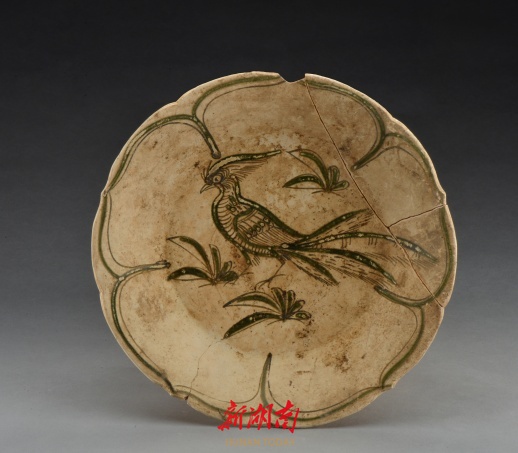
In mid April, on a sunny day after rain, the reporter drove about 30 kilometers northwest from Changsha to Tongguan Town located on the east bank of the Xiang River. Through the vicissitudes of time, although Shizhu Lake has disappeared, the complete process of making and firing has been preserved and restored in the Tanjiapo Ruins Museum. From the piles of porcelain fragments piled up like mountains, the glory of the past can still be seen on the more than 40 meter long Dragon Kiln site. The human voice is sparse, the world is lonely, and the distant ceramic atmosphere is dense and fragrant.
According to research, Changsha Kiln originated in the Middle Tang Dynasty, flourished in the Late Tang Dynasty, and declined in the Five Dynasties period. Since the discovery of the first ancient kiln site in 1956, more than 70 locations of the Tongguan ancient kiln site have been identified, scattered throughout the town. The archaeological team also discovered the remains of a ceramic market settlement centered around Shizhu Lake during the Tang and Five Dynasties period. What is a grass market? As the name suggests, it refers to a spontaneously formed folk market.
Due to the An Lushan Rebellion, a large number of northern kiln workers fled south and brought advanced porcelain making techniques. The Changsha kiln grafted the colorful glazed pottery craftsmanship of the Tang Dynasty's three colors onto the celadon porcelain of the Yuezhou kiln, integrating the northern and southern ceramic craftsmanship into one furnace, becoming a leader in the Tang Dynasty's colored porcelain kiln industry, breaking the pattern of "southern green and northern white" porcelain making at that time, and initially forming a tripartite balance of green, white, and color.
Blue, white, brown, green, and red, shining with colorful hues. When the wutong is planted, the phoenix will come.
Merchants from both China and abroad come in an endless stream, with boats and sails gathering on the river and wine shops lining the shore. Shizhucao City was once extremely prosperous, becoming a ceramic market that integrates production and sales, with both production and sales thriving.
Changsha kiln white glazed red green colored teapot.
2. Treasure exploration "Blackstone": the most active trendsetter on the Maritime Silk Road
Changsha kiln, made in the Tang Dynasty. A thousand years later, an ancient sunken ship once again unveiled this magnificent history.
In 1998, an Arab single masted triangular sail merchant ship, the Blackstone, was salvaged and brought out of the water in the western waters of Belidong Island, Indonesia. There are about 70000 items on board, including over 67000 ceramics, of which about 57500 are Changsha kiln porcelain. There are various items such as bowls, pots, screens, water bowls, candlesticks, etc.

The inscribed bowl of the "Heishi" water outlet, with the "Mingfan Family Record" in Shizhu Yuzi, Daocao City, Hunan Province "
The Black Stone model
Two blue glazed brown spotted painted bowls are particularly eye-catching. One of them is inscribed with a colored material on the center of the bowl, which reads "There is a Ming Fan Family Record on the Yuzi in Shizhu, Daocao City, Hunan Province". The other has an inscription on the outer wall, which reads "July 16th, the second year of the Baoli era". Zhang Xingguo explained, "The former clearly indicates the origin of the porcelain bowl workshop, while the latter indicates the production time of the porcelain bowl."
The Simbadas, who sailed a merchant ship to complete transactions in Shizhucao City, crossed the Xiangjiang River, Dongting, and Yangtze River, and then transported through ports such as Yangzhou and Guangzhou, have long been lost in the long river of history. And these goods that did not reach the other shore vividly prove that Changsha Kiln was the pioneer and main force of the Maritime Silk Road in the middle and late Tang Dynasty.
Modern archaeological excavations have shown that Changsha kiln porcelain has been unearthed in more than 20 countries and regions in Asia and Africa, with a wide distribution range that is astonishing. Even hundreds of years later, Zheng He's voyages to the West did not exceed this range.
At that time, a kiln could export tens of thousands of porcelain pieces at once, and its international trade capacity was astonishing.
"Large quantity, affordable price, and good quality." Zhang Xingguo summarized the reasons why Changsha kiln won the market. At that time, Changsha kiln was in its heyday and had a huge output. In Shizhu Grassland Market, three to five copper coins are enough to exchange for a porcelain pot. The bowls on the "Black Stone" are cheaper, while Yue kiln porcelain from the same period is priced at a thousand wen per bottle. Kiln owners are also willing to innovate and can customize according to the preferences of foreign buyers. They incorporate a large number of foreign cultural elements such as Hu Xuan dance, coconut date patterns, and Sogdian style, resulting in good sales.
This demonstrates the astonishing productivity and creativity of Changsha kilns, as well as the grandeur and innovative spirit of the Tang Dynasty.
The "Black Stone" ship produced a large number of Changsha kiln painted porcelain bowls.
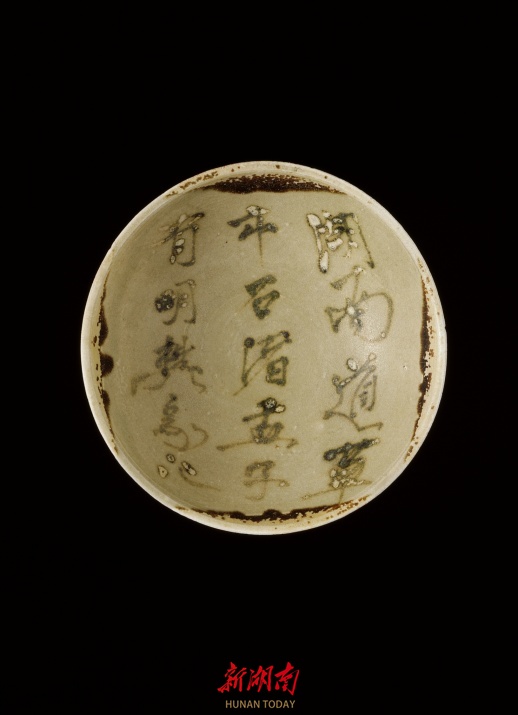
According to He Li, Deputy Director of the Changsha Tongguan Kiln Site Management Office, in November 2017, 162 cultural relics on the "Heishi" returned to their "birthplace" and settled in the Changsha Tongguan Kiln Museum. On April 11th this year, five of the cultural relics in the collection also served as cultural ambassadors and went to Beijing to participate in the "Sharing of Various Places - Silk Road National Museum Cultural Relics Exhibition", telling more people the story of the "Maritime Silk Road" from a thousand years ago.
3. Colored porcelain and blue and white: past lovers separated by 600 years
In 1717 AD, 600 fully armed Saxon guard cavalry assembled in the German city of Dresden and were ordered to go to Prussia. They were not carrying out combat missions, but were selected as exchange items by the Elector of Saxony and King Augustus II of Poland in the Holy Roman Empire, in exchange for over 100 pieces of Chinese blue and white porcelain collected by King William I of Prussia. The story of exchanging troops for blue and white porcelain has always been talked about, and it is also a great example of the popularity of Chinese blue and white porcelain in Europe.
Blue and white porcelain matured in the Yuan Dynasty and became popular in the Ming and Qing dynasties, making it a typical underglaze colored porcelain. Changsha kiln colored porcelain was once considered the source of underglaze color technology, and the local village name was changed to "Colored Pottery Source Village". Therefore, many people consider Changsha kiln colored porcelain as one of the important sources of blue and white porcelain.
However, there has been constant controversy in the academic community over this matter, with over 60 years of formation of three schools: the underglaze color school, the overglaze color school, and the overglaze and underglaze combination school. Each faction strongly supports their own views, but cannot fully persuade the other.
The details of history are rich and vivid. To approach the truth of history, one must not only boldly imagine, but also carefully verify.
In recent years, experts have conducted optical microscopy observations on colored porcelain specimens and randomly selected over 100 pieces of Changsha kiln colored porcelain fragments, all of which are overglaze colored. So far, no underglaze colored pieces have been found. Have Changsha kiln craftsmen ever used the underglaze color technique? This inevitably raises questions.
So, is there any connection between these two colored porcelain products that differ by about 600 years?
"Their relationship is just like the famous love poem from Changsha Kiln, 'You gave birth to me before I was born, but I gave birth to you old. You hate me for being born late, but I hate you for being born early.' They are lovers, just lovers from a past life, not only separated by 600 years, but also separated by a layer of glaze, one on the glaze and the other under the glaze. 'Zhang Xingguo's analogy is humorous and popular.
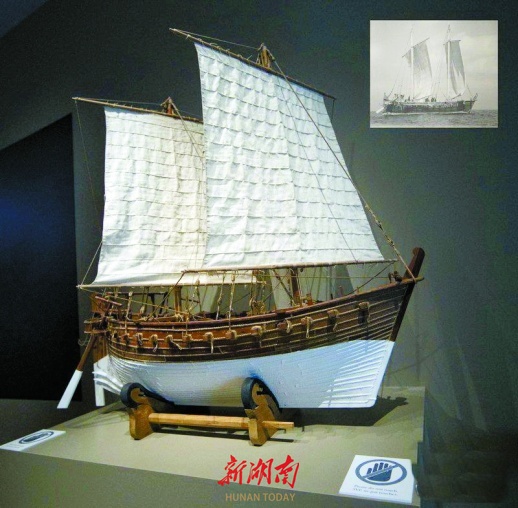
4. Poetic and pictorial: porcelain is elegant with calligraphy and painting, and calligraphy and painting are carried with porcelain.
"The spring water and spring pond are full, and spring grass grows in spring. Spring people drink spring wine, and spring birds listen to the sound of spring." This Tang poem, inscribed on a wine pot in Changsha kiln, uses eight words of spring to express the meaning of spring. The sentence is concise, catchy, and full of poetic interest.
On January 14, 2018, on the CCTV program "National Treasures", this blue glazed brown colored "Spring Water and Spring Pond Full" poetry and prose teapot, along with a T-shaped silk painting from the Fang Lei and Xin Zhui Tomb, represented the treasures of the Hunan Provincial Museum and participated in the "treasure competition", winning enthusiastic attention from the audience.
Changsha Kiln Blue Glazed Brown Colored "Spring Water and Spring Pond Full" Poetry and Literature Holding Pot.
Changsha kiln has many innovations, such as attempting high-temperature copper red glaze, being the first to enter commercial advertising slogans, rich decorative techniques, and so on. Among them, the most memorable is the poetic and picturesque atmosphere on porcelain.
"Porcelain is elegant with calligraphy and painting, and calligraphy and painting are embodied in porcelain. Changsha Kiln incorporates poetry, calligraphy and painting art into porcelain, enhancing its quality and cultural connotation." Li Jianmao, Secretary of the Party Committee and Deputy Director of the Hunan Provincial Museum, commented.
A love poem like "Farewell travels thousands of miles, with no expected arrival. On the thirtieth day of the month, there is no night without longing." It leaves a lasting impression on people.
The 12 characters "ancient people did not thank their horses and carriages, but now every inch of grass must be rewarded" express a sigh of regret that the present is not as good as before and the world is desolate.
"The fish caught in the air regret not being able to endure hunger." "The bird caught in a trap regrets not flying high." The admonition of using objects to describe people advises people not to be greedy and avoid evil consequences.
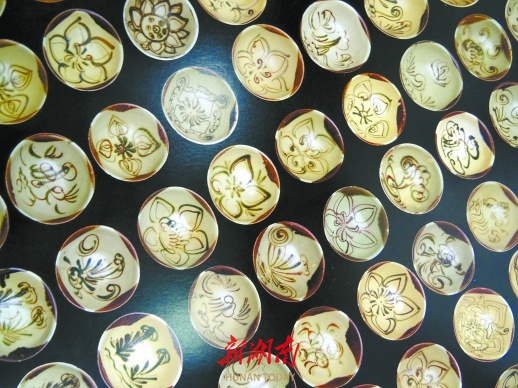
This is a magnificent treasure trove of folk literature and art. According to statistics, there are over 190 artifacts with inscriptions unearthed from the Changsha kiln site, including over 60 non repetitive poems and writings. Li Zhiyan, a researcher at the National Museum of China, said, "The Changsha kiln contains rich information on Tang Dynasty poetry, which is a supplement to the" Complete Tang Poetry "."
It is precisely with this immortal chapter written by mud and fire that Changsha kiln porcelain appears crude yet elegant, ancient yet full of spiritual energy. The touching lines and colorful lines, after thousands of years, still emit an intoxicating artistic atmosphere.
Events
In 1956, the Cultural Relics Management Committee of Hunan Province conducted a cultural relics survey in the area of Wajiaping, Shutang Township, Changsha County, and discovered this important porcelain firing point.
In the summer of 1957, experts Chen Wanli, Feng Xianming, and Li Huibing from the Palace Museum conducted an investigation into the Tongguan Kiln site in Changsha, and initially recognized the difference between the kiln site and the Yuezhou Kiln. They named it "Changsha Kiln".
In the winter of 1959, Feng Xianming and Li Huibing conducted another on-site investigation of the Tongguan Kiln site in Changsha. Feng Xianming wrote an investigation report and gave high praise, believing that the decoration method of colored porcelain went beyond the general rules of the Tang Dynasty and broke through the traditional monochromatic glaze. "Brown and green colors are all underglaze colors," making him the "ancestor of blue and white porcelain.".
From the end of 1964 to the spring of the following year, kiln sites were also discovered in Shizhu, Laoyao, and Youchuanzui on the south side of Shizhu.
In April, November to December 1983, the Hunan Provincial Museum and the Changsha Cultural Relics Work Team excavated a total of 7 excavation sites and 7 kiln sites at 8 locations including Lananzui, Tanjiapo, Liaojiapo, Jianzishan, and Dusipo. Among them, one whole dragon kiln was Tanjiapo No.1 kiln, and the rest were all remnants. The excavation covers an area of 400 square meters and a total of 7211 ceramic artifacts were unearthed. Experts such as Zhou Shirong immediately applied for and included Changsha kiln in the "National Seventh Five Year Key" scientific research plan, achieving significant results in the research stage.
In January 1988, Changsha kiln was announced as the national key cultural relics protection units.
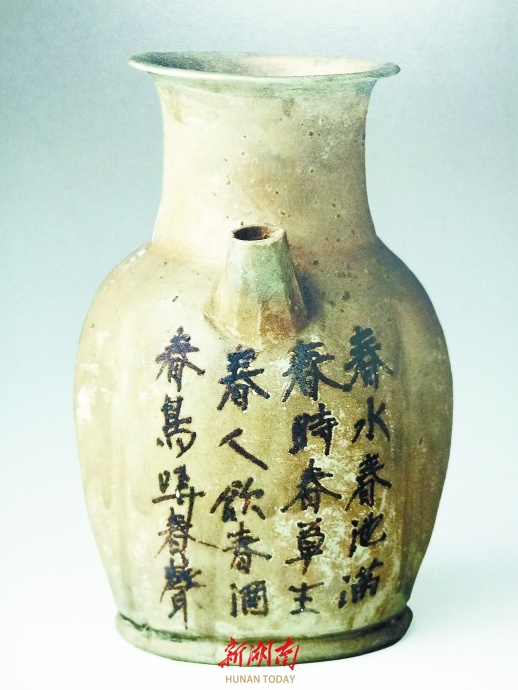
In November 1999, the Changsha Institute of Cultural Relics and Archaeology conducted excavations in Lananzui, and unearthed 1692 distinguishable ceramic artifacts.
From 2010 to 2017, in order to cooperate with the construction of the Changsha Tongguan Kiln National Archaeological Site Park and its supporting service facilities project, the Hunan Provincial Institute of Cultural Relics and Archaeology conducted continuous archaeological investigations, excavations, and research on the site, explored the scale, layout, and nature of the site, conducted a large amount of scientific testing and analysis work, and proposed new insights into the technological attributes of Changsha Kiln colored porcelain.
■ Comments
The Tang Dynasty was the heyday of China's land transportation, represented by the famous Silk Road at home and abroad, which people have a full understanding. At the same time, the Tang Dynasty was the founding period of large-scale maritime exchanges in ancient China, and ceramics were the most important goods in maritime trade at that time. The reason why we want to emphasize the concept of "large-scale" is that the communication with the outside world by sea began very early in ancient China. During the Qin and Han Dynasties, Chinese ancestors had already mastered more mature offshore navigation technology, and individual voyages could already reach the southeast coast of India and Sri Lanka.
From the 9th to the 10th century, shortly after its founding, the export of porcelain developed rapidly in terms of sales scope, sales scale, and the type and quality of artifacts, reaching a peak period, that is, the first peak period of Chinese porcelain export. During this period, the maritime ceramic trade has formed a trade of tens of thousands or even hundreds of thousands of pieces. The characteristic of export porcelain is that the output products are produced in many important kilns in the north and south. In the 9th century, the main products were mainly Changsha kiln porcelain, and in the 10th century, Yue kiln celadon was the main product. At that time, three trade circles were formed in the Indian Ocean Rim, and China's direct trade destination should have been the Great Harbor, located in the Kingdom of Vriffo on Sumatra Island.
-- Qin Dashu, professor and doctoral supervisor of the School of Archaeology, Peking University
The stages of Changsha kiln can be divided into: Yuezhou kiln period, evolution period, prosperity period, blank period, and decline period.
The period from the late Eastern Han Dynasty to the prosperous Tang Dynasty was the Yuezhou kiln period. The Changsha kiln was located in the peripheral kiln area of Yuezhou kiln in the early days, and celadon has been produced since the Eastern Han Dynasty. The period of evolution should be from the An Lushan Rebellion to the turn of the 89th century. The emergence of Changsha kiln is actually a product of the fusion of North South porcelain art. It is neither the result of the development of Yuezhou kiln nor a simple implantation of porcelain making technology in the Central Plains region, but a result of the fusion of the two. And there are characteristics that are different from other kilns, such as a new product based on the foundation of Nanqing and Beibai - colored porcelain, a special technique of calligraphy and painting to decorate porcelain, a paradigm of mold printing and decals, tea and wine utensils developed for the fashionable culture of tea and wine, and newly made foreign products for export, etc. The period from the year 870 AD, marked by the "Blackstone" water porcelain era, was a period of prosperity. The period from the end of Xiantong to Ma Yin Dingchu was a blank period. During the prosperous period, there were many chronological ceramics with almost no gaps. But since the two chronological porcelain works during the Xiantong period, there has been a gap in chronological porcelain for many years. What is the reason for the sudden cessation of the flourishing Changsha kiln? It is related to the Huangchao Uprising and the turmoil in the late Tang Dynasty. The decline period was during the Five Dynasties period. The main sales channel in Yangzhou was cut off by the war, and with the rise of Hengzhou kiln, Changsha kiln declined.
-- Li Jianmao, Secretary of the Party Committee, Deputy Curator, Research Librarian, and Vice President of the Chinese Ancient Ceramics Society of Hunan Provincial Museum

The Changsha Tongguan Kiln Site was the most important base for colored and exported porcelain in southern China from the late Tang Dynasty to the Five Dynasties period, reflecting the highest level of handicraft production in Hunan at that time and an important historical witness to commercial trade.
How to make the site come to life? On the basis of archaeological excavations, the protection exhibition of Tanjiapo No.1 kiln, which reflects the technology of Changsha kiln porcelain industry, not only displays a complete dragon kiln, but also displays the supporting workshop relics. The display methods are also diverse: there are both original real relics, as well as porcelain kiln restoration and models; There are both archaeological specimens and imitation colored porcelain; There are both signage instructions and voice guidance; There are both archaeological sites and virtual restoration; There are both archaeological achievements and archaeological processes; There are both protection greenhouses and protection monitoring; There is both a display of relics and a pottery experience. In such public spaces, archaeological excavation, research, cultural relic protection, display and utilization are integrated into one, with multifunctional superposition and integration, which is a rare example in the display and utilization of archaeological heritage both domestically and internationally.
-- Guo Weimin, researcher and director of Hunan Institute of Archaeology and director of Chinese Archaeological Society




